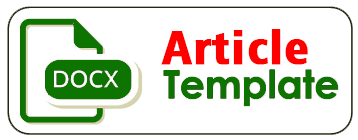Analisis Variasi Holding Time dan Injection Temperature terhadap Penyusutan Produk Funnel Pada Cetak Plastik Injeksi
DOI:
https://doi.org/10.32528/jp.v8i2.1054Keywords:
cetak plastik; funnel; holding time; injection temperature; penyusutanAbstract
Tingginya penggunaan produk plastik karena plastik mempunyai beberapa keunggulan seperti ringan, tahan korosi, mudah dibentuk, dan murah harganya. Kecenderungan konsumen lebih memilih menggunakan produk plastik menyebabkan produsen bersaing untuk memproduksi yang dibutuhkan konsumen. Produsen sebagai penghasil produk plastik berusaha meningkatkan kapasitas dan kualitas produksi. Tujuan penelitian adalah untuk mengetahui pengaruh parameter holding time dan injection temperature terhadap penyusutan produk funnel menggunakan material polypropylene. Dimana parameter holding time dan injection temperature berpengaruh terhadap efisiensi waktu yang berdampak pada kualitas dan kapasitas produksi. Metode untuk pengambilan data adalah eksperimen. Penelitian ini menggunakan variabel bebas holding time dan injection temperature. Variabel terikat yaitu penyusutan produk corong (funnel). Hasil penelitian dapat disimpulkan bahwa variabel bebas holding time dan injection temperature terhadap penyusutan produk funnel, yang terbaik di temperature 185 oC dan holding time 1,5 detik.
References
Kitayama S, Tamada K, Takano M, Aiba S. Numerical optimization of process parameters in plastic injection molding for minimizing weldlines and clamping force using conformal cooling channel. Journal of Manufacturing Processes. 2018 Apr 1;32:782–90. doi: 10.1016/j.jmapro.2018.04.007
Farotti E, Natalini M. Injection molding. Influence of process parameters on mechanical properties of polypropylene polymer. A first study. Procedia Structural Integrity. 2018 Jan 1;8:256–64. doi: 10.1016/j.prostr.2017.12.027.
Gao H, Zhang Y, Fu Y, Mao T, Zhou H, Li D. Process parameters optimization using a novel classification model for plastic injection molding. The International Journal of Advanced Manufacturing Technology. 2018;94(1):357–70. doi: 10.1007/s00170-017-0812-1.
Mohan M, Ansari M, Shanks RA. Review on the effects of process parameters on strength, shrinkage, and warpage of injection molding plastic component. Polymer-Plastics Technology and Engineering. 2017;56(1):1–12. doi: 10.1080/03602559.2015.1132466.
Hentati F, Hadriche I, Masmoudi N, Bradai C. Optimization of the injection molding process for the PC/ABS parts by integrating Taguchi approach and CAE simulation. The International Journal of Advanced Manufacturing Technology. 2019;104(9):4353–63. doi: 10.1007/s00170-019-04283-z.
Wijaya, H. (2015). Teknologi Pengolahan Plastik Injection Molding, e-Book. Bekasi.
Mawardi, I., Hasrin, & Hanif. (2015). Analisis Kualitas Produk dengan Pengaturan Parameter Temperatur Injeksi Material Plastik Polypropylene (PP) Pada Proses Injection Molding. Malikussaleh Industrial Engineering Journal Vol. 4 No.2, 30-35. doi: 10.53912/iejm.v4i2.110.
Iskandar, N., & Vendiza, F. R. (2019). Analisis Cacat Short Shot Dalam Proses Injection Molding Pada Komponen Shroud Fan . Prosiding SNST 10, 101-106.
Khadliq, M., Budiyantoro, C., & Sosiati, H. (2017). Komparasi Parameter Injeksi Optimum Pada Hdpe Recycled Dan Virgin Material. Jurnal Material dan Proses Manufaktur Vol. 1, No.1, 11-20.
Budiarto. (2002). PERANCANGAN PERALATAN PENCETAK, Modul. Bandung: Politeknik Manufaktur Bandung.
Firdaus M. Pengaruh Variasi Temperatur Injeksi Pada Rancang Bangun Mesin Injection Molding Untuk Hasil Produk Particulate Composite. 2020.
Prasanko AW, Djumhariyanto D, Triono A. Analisis Parameter Injection Molding Terhadap Waktu Siklus dan Cacat Flash Produk Tutup Botol 180 ml Menggunakan Metode Taguchi. Jurnal ROTOR. 2017.
Nurhudha A. Simulasi Dan Analisa Proses Injection Molding Pada Produk Frame Faceshield Untuk Reduksi Sink Mark. 2021.
Liu J, Guo F, Gao H, Li M, Zhang Y, Zhou H. Defect detection of injection molding products on small datasets using transfer learning. Journal of Manufacturing Processes. 2021;70:400–13.
Hwang S, Kim J. Injection mold design of reverse engineering using injection molding analysis and machine learning. Journal of Mechanical Science and Technology. 2019;33(8):3803–12.
Zwicke F, Behr M, Elgeti S. Predicting shrinkage and warpage in injection molding: Towards automatized mold design. In AIP Publishing LLC; 2017. p. 100001.
Gotlih, Janez, Miran Brezoenik, and Igor Drstvensek. 2018. “Influence of Injection Molding Process Parameters on Part Quality.” 42(January): 0–7.
Chang, Tao C., and Ernest Faison. 2001. “Shrinkage Behavior and Optimization of Injection Molded Parts Studied by the Taguchi Method.” Polymer Engineering and Science 41(5): 703–10.
S. Sulistyono and A. Dani, “Variasi Waktu dan Tekanan Injeksi terhadap Perubahan Berat Produk Corong pada Cetak Plastik Sistem Injeksi,” 2023, doi: 10.32528/jp.v7i2.9235.

Downloads
Published
How to Cite
Issue
Section
License
Copyright (c) 2024 Sulistyono Sulistyono, Elka Faizal

This work is licensed under a Creative Commons Attribution-NonCommercial-NoDerivatives 4.0 International License.








